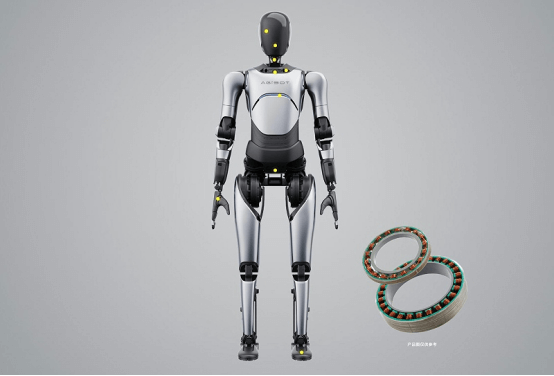
News Center
Why Frameless Torque Motors Power the Core of Humanoid Robots
Published on.
2025-06-24 11:57
Source
Do you remember the impressive humanoid robot performance at the Chinese New Year Gala? With seamless, fluid, and lifelike movements, these robots amazed the audience and raised a compelling question: how do humanoid robots achieve such high levels of flexibility and precision in motion?

Among the many core components of a humanoid robot, one powerful yet often overlooked technology plays a pivotal role—the frameless torque motor. Acting as the "heart" of the robot, it delivers high torque, precision, and responsiveness essential for smooth, lifelike movement. In this article, we explore why frameless torque motors are becoming the driving force behind advanced humanoid robotics.
What Is a Frameless Torque Motor?
A frameless torque motor is a type of direct drive motor that eliminates the traditional housing structure used to support the rotor and stator. It consists of two main components: the stator and the rotor.
The rotor is typically a steel ring embedded with permanent magnets and is mounted directly onto the drive shaft. The stator, composed of copper windings on laminated cores, is fixed to the mechanical structure. When powered, the interaction between the stator’s rotating magnetic field and the rotor’s magnetic field generates torque. Its operating principle is similar to that of a brushless DC motor.

Application Scenarios of Frameless Torque Motors
Frameless torque motors were initially adopted in collaborative robots. With advances in robotics technology, their usage has rapidly expanded into humanoid robots, which now account for approximately 80% of their application market. These motors are also being deployed in high-end industrial fields such as medical devices and aerospace systems.
Notably, a single humanoid robot may require as many as 28 frameless torque motors. This high integration density means that the growing demand for humanoid robots will directly drive an increase in the adoption and production volume of frameless torque motors.
Key Features of Frameless Torque Motors
1. Housing-Free Design for Flexible Integration
Without an external housing, frameless torque motors offer exceptional flexibility during installation. They can be directly embedded into compact or complex mechanical systems, making them ideal for humanoid robots where internal space is limited. This open integration approach enhances design freedom and system compactness.
2. High Pole Count for Greater Torque Density
Frameless torque motors typically feature a high pole count—often 16 poles or more—compared to traditional brushless motors, which generally have only 4 to 8 poles. According to electromagnetic theory, torque output increases with the number of pole pairs. As a result, frameless torque motors deliver higher torque density in a compact form factor, enabling humanoid robots to easily perform complex and dynamic movements.

3. Closed-Loop Control for Precision and Stability
Frameless torque motors typically rely on high-resolution encoders to provide real-time rotor position feedback. This enables precise control of current and position through closed-loop feedback, ensuring stable and accurate motion essential for humanoid robotics.
4. Low Inertia for Fast Dynamic Response
Frameless torque motors exhibit low rotational inertia with the rotor directly coupled to the load. As a result, they respond quickly to commands involving start, stop, or directional changes. This rapid responsiveness is critical for humanoid robots performing frequent, complex movements in dynamic environments, improving agility and task execution efficiency.
As the "heart" of humanoid robots, frameless torque motors provide the critical driving force behind smooth, flexible movement. With advantages such as housing-free integration, high torque density, precise closed-loop control, and rapid dynamic response, these motors are essential for meeting the complex motion demands of next-generation robotics.
As the humanoid robotics industry continues to evolve, frameless torque motors will play an increasingly vital role in advancing system performance. HONEST Automation, a trusted provider of intelligent motor assembly solutions, leverages over a decade of R&D experience to support the efficient production and seamless integration of frameless torque motors, empowering manufacturers to lead in the era of intelligent robotics.
Previous page
Related News






